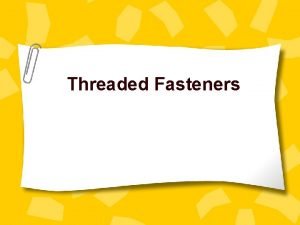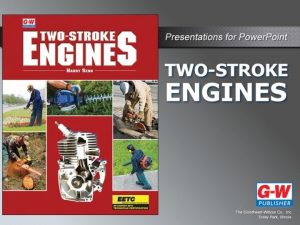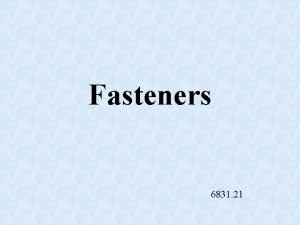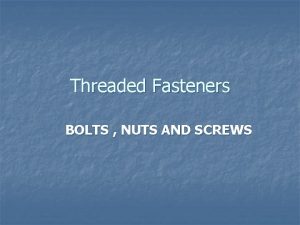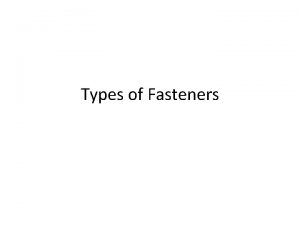Fasteners This work is licensed under the Creative


















- Slides: 18

Fasteners This work is licensed under the Creative Commons Attribution 4. 0 International License. To view a copy of this license, visit http: //creativecommons. org/licenses/by/4. 0

• Disclaimer • This workforce product was funded by a grant awarded by the U. S. Department of Labor’s Employment and Training Administration. The product was created by the grantee and does not necessarily reflect the official position of the U. S. Department of Labor. The U. S. Department of Labor makes no guarantees, warranties, or assurances of any kind, express or implied, with respect to such information, including any information on linked sites and including, but not limited to, accuracy of the information or its completeness, timeliness, usefulness, adequacy, continued availability, or ownership. • Content was changed from its original format to comply with copywriter laws.

Bolts • Most common on most machines (hex head bolts, and socket head bolts) • Made in standard sizes starting at ¼” and increasing by 1/16” up to 5/8” and in 1/8” steps up to 1” • Come in either coarse thread or fine, also right hand (most common) and left hand threads

Bolt Parts

Identification SAE (Standard) Metric

SAE Markings

SAE Nuts • Grade 2 -no marking or • Grade 5 - • Grade 8 -

Metric Markings

Left Hand Markings Some bolts and nuts have an “L” or “LH” to signify left hand threads as well as these

Why left hand threads? • There are many uses in industry for left hand threads • • • Left hand pedal on a bicycle Left hand grinding wheel on a bench grinder Lug nuts on some cars and trucks Cryogenic tanks Instances where a right hand thread would loosen

Other Markings • Bolts and nuts can have other markings from different manufacturers or different materials • Manufacturers sometimes put company logos, initials, or other identification on hardware • Stainless steel hardware also has different markings that identify the grade and hardness

Thread Sizes • For all SAE bolts there are 2 thread sizes • UNC-Unified National Coarse thread • 1/4 -20 UNC-less threads/inch • UNF-Unified National Fine thread • 1/4 -28 UNF-more threads/inch • For ISO metric bolts the mm/thread is greater for coarse thread and less for fine thread but there can be many different thread variations for the same size bolt

Bolt Sizes Classifications SAE • ¼-20 -UNC • ¼=diameter of bolt in inches • 20=number of threads/inch • UNC=national coarse thread Metric • M 12 x 1. 5 • M=metric screw thread • 12=diameter of bolt in mm • 1. 5=number of mm between threads

Common SAE Threads

Common Metric Threads

Measuring Threads • Thread pitch gaugeeasiest way • SAE and Metric take different gauges • SAE-threads/inch • Metric-mm/thread • Another simple way is to find a mating part

Identifying Bolts • Identify if the bolt is standard or metric by looking for markings of grade • If no markings you can measure thread diameter • Measure thread diameter to get the nominal bolt size • This measurement will be slightly smaller than the nominal bolt size • Measure threads to find out metric mm/thread or threads /inch • This can be done with a thread pitch gage or any mating part • Measure the length of the shank and threads to get overall length • Measure across the flats of the head (or the inside of a socket head) to find the wrench size • Again this dimension will be slightly smaller than a nominal size

Identifying Nuts • Identify if the nut is standard or metric by looking for marks on the top or the side of the nut • If none are visible, measure the wrench size • To get wrench size, measure across the flat surfaces • This dimension will be slightly smaller than a nominal size • To get the major thread diameter, measure the inside of the hole • The measurement that you get is the tap drill size • Take this measurement and search the chart for a size that it belongs to To measure thread pitch use a thread pitch gage or a mating part
 This photo by unknown author is licensed
This photo by unknown author is licensed This photo by unknown author is licensed under cc by.
This photo by unknown author is licensed under cc by. This photo by unknown author is licensed under cc by-nd
This photo by unknown author is licensed under cc by-nd This photo by unknown author is licensed under cc by-sa
This photo by unknown author is licensed under cc by-sa This photo by unknown author is licensed under cc by-nc
This photo by unknown author is licensed under cc by-nc Author
Author Fastening
Fastening Non threaded bolt
Non threaded bolt Schraube fasteners turkey inc
Schraube fasteners turkey inc Axially loaded members
Axially loaded members Fasteners gaskets seals and sealants
Fasteners gaskets seals and sealants Types of threaded fasteners
Types of threaded fasteners Types of fasteners
Types of fasteners Building materials, fasteners, and adhesives
Building materials, fasteners, and adhesives Manufacturer for wood joint fasteners
Manufacturer for wood joint fasteners Flexco bolt solid plate fasteners
Flexco bolt solid plate fasteners Non-mechanical fasteners
Non-mechanical fasteners Torsional snap fit
Torsional snap fit Fasteners gaskets seals and sealants
Fasteners gaskets seals and sealants







